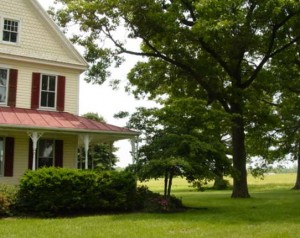Guest blogger: Lisa Mroszczyk
Yes, you read that right. Many older buildings, particularly those constructed prior to 1920, are green. May is National Preservation Month and the National Trust for Historic Preservation is using the month-long celebration to highlight the important role that older and historic buildings play in environmentally and economically sustainable communities.
Often, older buildings were designed and built to work with the environment. Buildings with operable windows provide natural ventilation and daylight. Covered porches, awnings and shutters reduce solar heat gain in the warmer months. Thoughtful orientation of the building on its site maximizes wind and sun patterns. In fact, U.S. Energy Information Agency research establishes that buildings built prior to 1920 are more energy efficient that those constructed in the 30s, 40s, 50s, 60s, 70s, 80s, and 90s. Not until after 2000 were buildings constructed to be more energy efficient than those built prior to 1920.
More thought and attention needs to be given to the sustainable qualities of older buildings before accepting arguments for demolition or unsympathetic alterations under the guise of concern about climate change.

Brains from my father
Not only were many older buildings designed with the environmentally friendly features you mentioned, most older houses are a lot smaller than today’s new house, which reduces their overall energy footprint.
Thayer-D
Gosh, and I thought old architecture was just a nostalgic regurgitation of historic styles. I’m so glad this idea is finally gaining currency. When you are forced to design either cities or buildings with-in tight technological and ecological boundries, the solutions are bound to contain some intelligent responses to the problem(s). Another element that makes a lot of the older building stock sustainable is that they where usually designed to be liked. In other words, there’s less of a chance they get torn down if people actually like them. Will people protest more if the FBI building goes to the wreacking ball or the old post office? Now if we could get architecture schools to focus beyond style and study/teach the qualities that made older buildings greener…
not holding my breath.
anthony pins
Thayer –
As someone who has spent the past year looking at architecture schools, I think you may be surprised at the number of schools with a specific focus on sustainability. DesignIntelligence, the yearly publication that reviews architectural education in the US specifically notes the schools that are lauded for their education in sustainable design practices and principles (Oregon, Berkeley, Texas, UVA, and Auburn top the list).
You’re probably correct that many schools focus on active technologies rather than passive sustainable design. Those efforts are important though because universities are (and should be) laboratories for innovation, and new technologies hold great promise as sources for renewable energy, and increased efficiency. Passive techniques are relatively basic, and while most people understand them, only few employ them. I think that is also beginning to change.
Thayer-D
Anthony,
I’m glad to hear that. It’s been a while since I was in school, where diversity consisted of LeCorbusier, Gropious, or Mies Van De Rohe. I forgot deconstructivism. As for innovation, I’m all for it, I think like any art/craft, starting with the basics (passive techniques) should be the basis of the active technologies you alluded to. I still think there’s a prejudice inherited from the modernists I mentioned against historical architecture, and unfortunatley for architects and our environment, they threw out the baby with the bathwater.